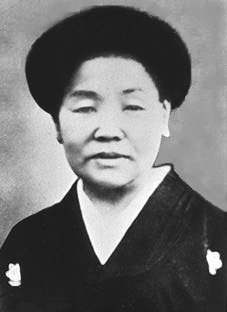Welcome
to
Founder Tatsuko Sugiyama
The late Most Rev. Tatsuko Sugiyama, Founder of Daijokyo, was born July 28, 1868. At 16 years of age she went to Ogaki City in Gifu Pref., Japan, where she visited a locally renowned practitioner of the Saddharmapundarika Sutra (the Lotus Sutra), the Rev. Kise Suzuki, one of whose devotees was Count Toda. At that time the fortunes of the Sugiyama family were in decline, owing to a series of tragedies. In her younger days, Rev. Sugiyama sought to restore the family’s losses by learning the Lotus Sutra from Rev. Suzuki.
At the age of 25, Rev. Sugiyama began to study the doctrine of the Lotus Sutra in depth and to practice an ascetic life in isolated places in Aichi Prefecture. She continued ascetic practices for about 20 years, during which period she fasted more than 40 times and purified herself by sitting beneath the torrents of a waterfall more than 50 times. One day, when she was purifying herself beneath a waterfall, she heard the voice of a deva. He said, “Stop these fruitless ascetic practices right now. Do not imitate fish. Rather, you must go into a coffin and think about what is the True Dharma.” Soon after this experience, Rev. Sugiyama abandoned asceticism and came to realize that propagating the Lotus Sutra among the people is the most important duty for Buddhists. In a deep samadhi, she realized the supreme doctrine of the Lotus Sutra, Ji-no-ichinen-sanzen (footnote 1) and understood that she would have to fulfill the task of Supratisthita-caritra Bodhisattva (Anryugyo-bosatsu), one of the four leading bodhisattvas who emerged from the earth (footnote 2).
In September 1914, with her first disciple, Dr. Itsuki Murakami of Aichi Medical College in Nagoya, Rev. Sugiyama established the lay Buddhist organization Bukkyo-kanka-kyusaikai (renamed Daijokyo in 1948). In the strong brief that true Buddhism must save the suffering people in society, Rev. Sugiyama and Dr. Murakami began propagating the teachings of the Lotus Sutra and launching salvation programs among those in despair.
In 1922, when the Fukagawa district in Tokyo was seriously damaged by flooding, Rev. Sugiyama hurried there to provide rice for the suffering people. In the same year, she also provided rice for thousands of needy people in Nagoya and Tokyo. In 1923, when the Kanto Earthquake destroyed the Tokyo metropolitan area, killing an estimated 100,000 people, Rev. Sugiyama set up a relief center inside Nagoya Station, where she served meals to survivors of the disaster, while seeing to it that vast quantities of food and medicine were shipped from the port of Nagoya to the port of Shibaura in Tokyo, with which to carry out relief operations for the suffering people.
Rev. Sugiyama also volunteered to help Hansen’s disease patients, providing them with both spiritual and medical care. While visiting numerous Hansen’s disease hospitals in various parts of Japan in order to console patients and provide financial support, she built her own hospitals for that disease in Nagoya and Fukuoka, Japan. Under difficult circumstances, she proved that her dual approach was an effective cure for Hansen’s disease.
“You must be pleased with the fact that you were born as a human and that you encountered the teachings of the Lotus Sutra in this lifetime. You should plant the roots of good merit to such extent that you would have no regrets were you to die tomorrow.” Leaving these words, Rev. Sugiyama entered nirvana on June 28, 1932. Her life had always been based on the spirit of Supratisthita-caritra Bodhisattva, whose vow is:
“No matter how innumerable sentient beings are, I vow to save them all.”
----------------------------------------------------------------
Footnote 1. Ji-no-ichinen-sanzen
Ichinen-sanzen, one of the most important doctrines of Buddhism in China and Japan, literally means that 3000 existences are contained in one thought. All phenomena in this world (sanzen) are included in a single thought (ichinen) of a practitioner.
On the basis of this doctrine, one can inherit the limitless merits and virtues of the Eternal Sakyamuni Buddha by chanting the title of the Lotus Sutra (Myo Ho Ren Ge Kyo).
Footnote 2. Supratisthita-caritra Bodhisattva (Anryugyo-bosatsu)
The Bodhisattvas who came out from openings in the earth (called Jiyu-no-bosatsu) are explained in the Lotus Sutra. They are said to be disciples of the Eternal Sakyamuni Buddha, entrusted by Sakyamuni Buddha with the task of propagating the Sutra after the parinirvana of Sakyamuni Buddha in the Saha world. Supratisthita-caritra Bodhisattva is one of their four great leaders.
The Great Buddha Statue in Bodhgaya, India
A brief biography of Most Rev. Tatsuko Sugiyama, Founder of Daijokyo


